
Quite possibly the finest use of the Youtube I’ve come across yet. You’re welcome.
Thanks to the redoubtable Jimi Hey !

Quite possibly the finest use of the Youtube I’ve come across yet. You’re welcome.
Thanks to the redoubtable Jimi Hey !
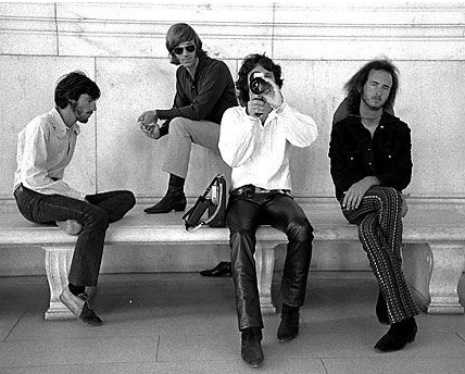
Listening to The Doors’ second album, Strange Days, while peaking on half a tab of Purple Owsley was one of those mindbending events that alter the course of a young man’s life forever. I was 16 years old, living in the suburbs of Virginia and, with the exception of a couple of freak friends, was pretty much alone in the world. There weren’t a lot of support systems during the Summer Of Love in the American South for a kid who wanted to explore his spiritual side. Organized religion had more than failed me, it terrified me. Catholicism spooked me so bad that even the sight of a nun or priest would send me rushing in a cold sweat in the direction of the nearest mental exit sign.
Getting LSD was the easy part. Knowing the best way to navigate the experience was the challenge. You just took the trip and put your faith in the loving hands of the cosmos. At least that’s what I did. Jim Morrison and his band mates were the dark guides on my solitary psychedelic journey.
Well the music is your special friend
Dance on fire as it intends
Music is your only friend
Until the end
Until the end
Until the end!
The Doors’ apocalyptic rock might seem like an entry way to a bad trip, but for me their music echoed and expanded upon an interior shadow world I had always been drawn to and their anti-authoritarianism played into my distrust of bully gods and their black-robed hitmen. LSD gave me a glimpse into the spiraling DNA that contained everything I needed to know about the Universe and all I had to do was crack the code.The Doors provided the soundtrack in my search for the key. A search that continues to this day. Breaking through to the other side turned out to be harder than I imagined.
Jim Morrison was the first rock star that tapped into the same rich vein of poetic dreaming that had lured me into the web of the French surrealists and the American counter-culture. Here was a young Navy brat, like myself, who drew inspiration from Rimbaud, Baudelaire, the Beats, The Living Theater and cinema. He took it all in and spun it back out into lyric-driven music that was familiar and strange at the same time. Intense and filled with mystery and sex, you couldn’t call it pop, but you could dance to it….or melt to it like a pillar of Biblical salt. In my rock and roll world, Morrison was the benign high priest who led me not so gently into a dark night of the soul shot through with glistening shards of seductive light.
Along with most of the rock groups I grew up with, I don’t listen to The Doors these days. The iconic songs of my youth are etched in my genes - musical scarification. I hear them whenever I want by tilting my head in the direction of the Akashic records that spin on turntables somewhere in the Bardo. Years of hearing “Light My Fire” and “When The Music’s Over” on classic rock radio has dulled some of the magic for me. Yet I still get excited when I see a new book on The Doors, particularly when it’s written by someone who was “there.” The thought that hidden secrets might be unlocked from old songs making them feel new again or that some lost piece of history has been unearthed like a rock and roll version of the Dead Sea Scrolls triggers little jolts of excitement along my spine as electric as a Nicolai Tesla neck massage. Yes, hope springs eternal for fools like me.
Greil Marcus’s new book The Doors: A Lifetime Of Listening To Five Mean Years teased me into thinking there might be something fresh to be said about The Doors. Marcus has a rep for knowing a thing or two about rock and roll and pop culture, so I assumed he’d bring something to the mix that lesser writers managed to overlook, you know, a different perspective. But Marcus fails in almost every respect to engage the reader. Even the most devout Doors’ fan will find this slim volume of overstuffed prose and wild tangents a numbing experience. The Marcus perspective consists of bloated descriptions of Doors’ songs and performances, descriptions that are so subjective and adjective heavy that at times it’s like reading Olympia Press fetish porn by someone named “Anonymous.”
The Doors is less a book about the band than it is the experience of being subjected to Marcus’s stream of consciousness vamps on Thomas Pynchon, cult flick Pump Up The Volume, Oliver Stone’s dreadful Doors movie, Val Kilmer’s post-Morrison career, 20th century pop art, Eduardo Paolozzi, the Manson Family and so on. None of which he connects in any compelling way to the subject at hand (the subject becoming less clear as the book lurches along). It’s as if Marcus put some of The Doors’ music on shuffle and started writing whatever popped into his head - a Jackson Pollock action painting connected to The Doors by the mere juxtaposition of sharing the same room as their music. There are threads of elegant symmetry in Marcus’s writing but the center wobbles like a bead of sweat on a brooding hipster’s brow.
Read The Doors to get inside of Greil Marcus’s head if that’s of interest to you. He’s a smart guy and the book gives him an opportunity to show it off. But as a book about one of the planet’s great rock bands, The Doors is a brainy wankfest in which little of any significance is actually said. No amount of pop culture name-dropping and metaphoric over-kill in describing The Doors’ art can obscure the fact that there’s a big hole where the soul of a book ought to be. Marcus claims to be a Doors’ fan and yet there’s little love for the band between the pages of this frustratingly irrelevant book. The Doors may have been a labor of love for Marcus, but for the reader it’s just labor.
Meanwhile, somewhere in the south of France, an overweight bearded poet is writing his autobiography about his early days as a rock star: The End by J.M.
Video: The Doors interviewed in New York in 1969 for public television.
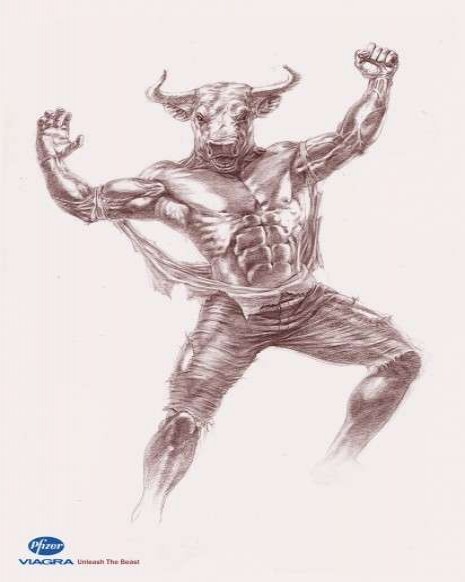
You fill in the blank for the new Viagra campaign out of Nairobi, Kenya. I like the title Copyranter gives ‘em “Viagra turns Kenyan men into horny, buff furries.” Trend Hunter says, “Humanimal Arousal Ads.”

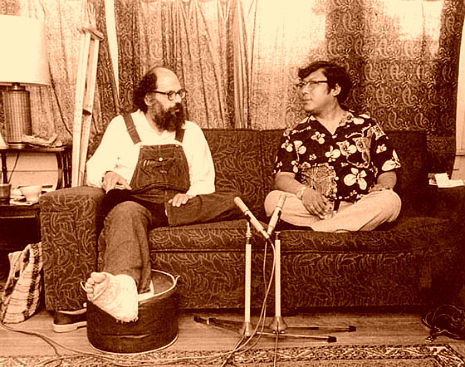
Ginsberg and Trungpa.
When I arrived in Boulder, Colorado in 1971 it was a small town with a big campus filled with privileged white kids. It was also home to thousands of hippies. I’d left Berkeley for Boulder drawn not by the institute of higher learning but by a desire just to get higher…literally. Convinced that a massive earthquake was imminent, I fled the Bay Area and headed for the higher ground of the Rocky Mountains. I had also been told by people I trusted that Boulder was my kind of town: Berkeley without the angst. Tibet of the West. And as a child I had lived in Boulder while my father attended the University (on the G.I. Bill) and I had distant memories of something magic about the place.
Boulder in the 70s was an easy mix of stoned and moneyed youth and rough-edged mountain Bohemia. On the fringes of the University, was a thriving arts and intellectual scene. Professors, hipsters, local poets, divinely intoxicated recalcitrant drunks and various combinations of all of the above would hang out at a downtown watering hole called Tom’s Tavern. Tom’s sold cheap beer, had a pool table and a jukebox stuffed with vintage rock, old standards and hillbilly music. It was the center of off-campus intellectual life in Boulder. Within the smoke stained and booze infused walls of Tom’s I found my University, a joint where Jean Paul Sartre could drink Hank Williams under the existential table while Arthur Rimbaud shimmied to “Mickey’s Monkey.”
I had always considered alcohol the drug of choice for straight people. It was my parent’s drug. Alcohol was for squares. But at Tom’s you drank. And that’s what I did. I started drinking. I also started getting serious about being a poet.
In 1971, Tibetan Buddhist master Chogyam Trungpa landed in Boulder and the mix of academia, back to naturists, spiritual seekers, old beatniks and young hippies was given an energizing and discombobulating dose of high-octane Crazy Wisdom.
Trungpa had developed a style of teaching meditation and Buddhist philosophy that was user-friendly for Westerners. Raised in the classic Tibetan monastic tradition as a child and later as a student at Oxford, Trungpa had the experience of ancient wisdom coupled with a modern education that allowed him to fluidly adapt to contemporary expectations and to challenge them. Unlike the kind of gurus most of us were accustomed to, Trungpa wore tailored suits, smoked menthol cigarettes, was a heavy drinker and known to have experimented with psychoactive drugs. He upended every holy man stereotype in the book. In his own sly way, Trungpa was shedding light on how superficial our ideas about “spirituality” are. As Catholics and Christians, many of us were substituting Bibles, crosses, crucifixes and rosaries for prayer beads and the Tibetan Book Of The Dead. Trungpa let it be known from the get-go that spirituality was more than just changing your costume.
Trungpa’s fresh approach to Buddhist instruction and initiation included methods that were controversial and his drinking and womanizing created a lot of scandal among the more conservative and traditional Buddhists, both in America and back home in Tibet. Sometimes his methods were as radical as the old Zen master who broke his student’s finger in order to bring the student into the moment. I experienced Trungpa’s teachings first hand and the results were mind-altering and soul-shaking.
I was celebrating Trungpa’s birthday (his 35th?) with a bunch of his students and friends at a home in the foothills above Boulder. Everybody was roaring drunk, including Trungpa. At one point, he grabbed the kitchen sink water hose and starting spraying everyone until we were all soaking wet. He then began hurling handfuls of birthday cake in all directions, landing a direct hit on my face. I grabbed some cake and threw it at him. With the speed and ferocity of a lion, Trungpa lunged forward and dragged me down to my knees by my hair, which was very long at the time. He yanked at my hair until tears flowed from eyes. After what seemed like an eternity, he let go of me and laughed. I was mortified.
Later that night I cut off all my hair. It was the first haircut I’d had in seven years. When I was 15 I had been expelled from school for being a longhair. I never went back to school and hadn’t cut my hair since. Looking in the mirror, I was appalled by how I looked. My identity had been so linked to my “freak flag” that I barely recognized the nerdish fellow staring back at me. My beautiful hair was gone and so was an important symbol of my freedom…a symbol that I had relied on for years to declare my independence, my spirituality and general grooviness. I had grown so attached to my hair and what I thought it stood for that I had become lazy in developing other ways of being truly free. At least that’s the conclusion I came to based on what I felt was a lesson from Trungpa.
I was certain that Trungpa’s hair-pulling rage was a mystical transmission of a profound teaching, a bit of the old Crazy Wisdom. I was absolutely convinced that Trungpa’s actions were much more than just a drunken reaction to my tossing cake at him. I was the recipient of something ancient and precious. This is the kind of thing that happens in a guru/student relationship. The student reads and projects a lot into whatever the guru does, whether there’s anything there or not. But it doesn’t matter whether or not the teacher is teaching. All that mattered to me is that I was compelled to question my identity, my ego, my reliance on exterior symbols as substitutes for real wisdom and real freedom. I was also reminded of one of the main reasons I had grown my hair long in the first place: I have big ears.
I felt so naked and uncool with short hair that I went into a self-imposed exile until it started growing back. I went so far as to stop seeing my girlfriend Mimi. So in addition to being a recluse, I was also a celibate.
The “hair teaching” was yielding all kinds of unexpected results. I was hurled into the life monastic. I was Thomas Merton with Alfred E. Neuman’s ears. “What me worry?” Yes, I was worried all the time. Worried that by the time my hair grew back Mimi would find someone else. And she did. She left me for one of the biggest pot dealers in Colorado. This betrayal escalated my self-pity into self-loathing on a grand scale.
At 22 years old, I had entered my dark night of the soul over a fucking haircut. A blow to my ego and vanity exposed just how firmly strapped to the Wheel Of Samsara (illusion) I really was and the whole fucking game was blown wide open by a drunk Tibetan guy covered in birthday cake.
My hair grew back and a few years later I cut it again. This time I wore it as a Mohawk that I dyed silver. The freak flag was still flying but with a whole lot less at stake. Hair comes and goes, but the ego is forever…until it isn’t.
I could write a book on what it was like being around Chogyam Trungpa Rinpoche during those wild days in Boulder. He started a school (Naropa) which drew my literary and counter-culture heroes to our Colorado town. The collective energy surrounding him was madly magnificent. Poets and prophets everywhere: Allen Ginsberg, Robert Creeley, William Burroughs, Gregory Corso, Diane di Prima, Jack Collom, Timothy Leary, Amiri Baraka…the list was long and impressive. They were all coming to Boulder to study with, observe or challenge this young Tibetan sage. They would eventually pull it all together in a branch of Naropa called “The Jack Kerouac School Of Disembodied Poetics.”
As the scene continued to gather momentum, I ended up managing a beautiful old hotel in Boulder where Ginsberg, Burroughs, Corso and other poets and artists took up residence for a while. I sat at Ginsberg’s feet and read him my poems. He was patient. But I was a pretty boy and he enjoyed my company. I drank with Corso and listened to his high-pitched rants. Burroughs was the mystery man up on the top floor guarded by his mellow and diligent assistant James Grauerholz. I organized impromptu poetry readings in the lobby of the hotel and people would be hanging from the rafters as some of America’s greatest bards proclaimed, sang and shouted at the heavens.
When I write the book, I’ll recall the night my punk band performed at a Boulder nightclub with Allen Ginsberg and his mighty harmonium as our opening act. He sang from Blake’s “Songs Of Innocence And Experience” and I stood offstage and watched him and realized how fucking lucky I was to be so close to someone who literally changed my life when I first heard him read “Kaddish” on a vinyl record that Carla Bombere (my beatnik girlfriend) gave me to listen to when I was 15 years old. And not far from where I was standing was another young guy taking it all in, a teenager named Eric who helped my band carry our equipment. A few short years later he’d change his name to Jello Biafra and begin his own unique bardic journey.
Chogyam Trungpa’s arrival had a seismic affect on this lovely town at the foot of the Rockies. Whatever magic exists in Boulder wasn’t created by Trungpa, but he was certainly a big part of activating it. And the Naropa Institute continues to sustain that magic. The last time I was there a few years ago, I noticed that Thurston Moore from Sonic Youth was walking the grounds and soaking it all in.
There are those who think of Trungpa as some kind of charlatan, an exotically charming scam artist who beguiled a bunch of gullible people into buying into a bastardized form of Buddhism. I hear it all the time. But take it from someone who was there, Chogyam Trungpa Rinpoche was the real deal. In asking us to look past spiritual materialism, he included himself. Look past the teacher into that formless void from which all things of the ego arise. The great teachers offer us a glimpse into nothingness and Trungpa was a great teacher. His willingness to get down in the trenches with his students is often mistaken as a weakness in his own character. Aren’t gurus supposed to be above it all? Trungpa didn’t give a shit about the games gurus play. Trungpa worked from the ground up, taking energy from wherever he got it and using it to set a fire under his students that would eventually burn away some of the bullshit and illuminate the illuminated. Was he a perfect teacher? Probably not. But that’s what made him special. It was his humanity and accessibility that made him such an effective teacher. There’s nothing remote or exotic about Buddhism. It’s really rather plain and ordinary. Kind of like the nose on your face. Or in my case, the ears.
In the raw documentary Fried Shoes Cooked Diamonds , director Costanzo Allione captures some of the communal craziness and excitement that was flowing through Boulder while Trungpa was living and teaching there. It was an exhilarating time and important period in the evolution of America’s Buddha nature.
Watch another fine documentary, “Crazy Wisdom,” on the Naropa scene after the jump…
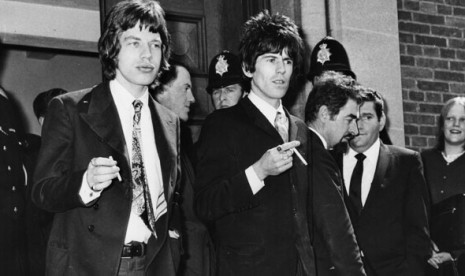
The recent News of the World ‘phone hacking scandal wasn’t the first time the red top used illicit means to obtain stories. Back in the swinging sixties, the paper regularly bartered with the police for information to use in its pages.
One of the News of the World’s tip-offs to the cops led to the most infamous drugs trial of the twentieth century, where Mick Jagger, Keith Richard of The Rolling Stones, and art dealer Robert Fraser were imprisoned in an apparent attempt to destroy the band’s corrupting influence over the nation’s youth.
For the first time, the true story behind the arrests and trial is revealed by Simon Wells in his excellent book Butterfly on a Wheel: The Great Rolling Stones Drugs Bust. Wells’ previous work includes books on The Beatles and The Stones, British Cinema and most recently, a powerful and disturbing biography of Charles Manson. In an exclusive interview with Dangerous Minds, Wells explained his interest in The Stones drugs bust:
‘As a student of the 1960s it was perhaps inevitable that I would collide with the whole Redlands’ issue at some point. Probably like anyone with a passing interest in the Stones, I first knew about it mainly from legend - the “Mars Bar”, the fur rug, the “Butterfly On A Wheel” quote etc. However, like most of the events connected to the 1960s, I was aware that there had to be a backstory, and not what had been passed down into myth. This story proved to be no exception, and hopefully, the facts are as sensational (if not more) than what has passed into mythology. Additionally, as a Sussex boy - I was familiar with the physical landscape of the story- so that was also attractive to me as well.’
Just after eight o’clock, on the evening of February 12 1967, the West Sussex police arrived at Keith Richards’ home, Redlands. Inside, Keith and his guests - including Mick Jagger, Marianne Faithfull, the gallery owner Robert Fraser, and “Acid King” David Schneiderman - shared in the quiet warmth of a day taking LSD. Relaxed, they listened to music, oblivious to the police gathering outside. The first intimation something was about to happen came when a face appeared, pressed against the window.
It must be a fan. Who else could it be? But Keith noticed it was a “little old lady.” Strange kind of fan. If we ignore her. She’ll go away.
Then it came, a loud, urgent banging on the front door. Robert Fraser quipped, “Don’t answer. It must be tradesmen. Gentlemen ring up first.” Marianne Faithfull whispered, “If we don’t make any noise if we’re all really quiet, they’ll go away.” But they didn’t.
When Richards opened the door, he was confronted by 18 police officers led by Police Chief Inspector Gordon Dinely, who presented Richards with a warrant to “search the premises and the persons in them, under the Dangerous Drugs Act 1965.”
This then was the start of the infamous trial of Mick Jagger, Keith Richards and Robert Fraser.
It may seem we all know a small piece of this story, but in fact as Butterfly on a Wheel: The Great Rolling Stones Drugs Bust shows, we’ve never seen the whole picture until now:
‘It was such a well-known story, I was amazed no one had written a book about it before. It’s one of the most incredible stories of the 20th-century and I couldn’t believe that it had been ignored - given that every other angle of the Stones in the 1960s had been thoroughly explored. Obviously, as I worked my way through the story I became aware of just how the mythology of the tale had been constructed over the years. For a decade awash with drugs, it was somewhat predictable that the events that night had been blown up to such a stratospheric level.’
Wells has written a 5 star book, which explains the full background story, bringing new information to the events surrounding the bust, with particular emphasis on the nefarious activities of the News of the World and a dodgy copper, Detective Sergeant Norman “Nobby” Pilcher.
‘I suppose it was predictable during the star-studded 1960s that London’s otherwise anonymous police force would create their own celebrity copper. In this case it was Detective Sergeant Norman Clement Pilcher,’ says Wells. ‘Norman or “Nobby” as he was known to his colleagues was quite a character, as was his insatiable desire to rise swiftly through the ranks of London’s police. Pilcher may well have had an agenda to curb the activities of London’s musicians, but my own take on him was that he knew the value a celebrity bust. While seemingly the majority of the capital’s youth were engaged in some form of narcotic use, Picher knew that busting a celebrity would raise his profile (and by association, his team) enormously.’
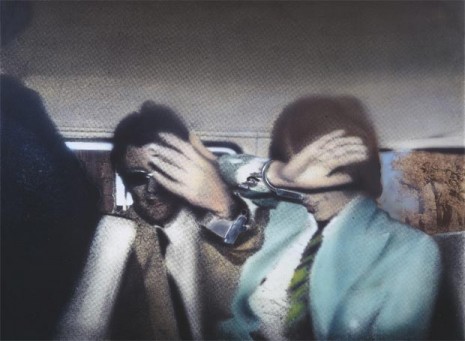
Richard Hamilton’s portrait of Mick Jagger and Robert Fraser under arrest.
Pilcher waged a war on pop’s elite. During his time at the Drugs Squad, Pilcher was responsible for arresting Donovan, Brian Jones, John Lennon and George Harrison. Pilcher always got his man, by bringing along to any bust his own supply of evidence. He was lampooned as a rock groupie by underground magazine Oz, and John Lennon described him as ‘semolina pilchard, climbing up the Eiffel Tower’ in “I Am The Walrus.”
In our present world of anodyne music pumped out by record labels and TV talent shows as a soundtrack for malls, lifts, and supermarkets, it is hard to believe that once-upon-a-time, music, in particular pop music, was considered revolutionary and a very real threat to the established order. Think of this when imagining the world The Rolling Stones burst into back in 1963, as it was the Stones, their music and their alleged drug use that became the focus of British establishment’s ire.
‘As far as attitudes towards soft drug use were concerned,’ Simon explains, ‘I would say it was the most important moment of the 20th century. A massive watershed of opinion that for the first time pitched elements of the so-called “Establishment” against the rebellious young - best exemplified in the metaphor of The Rolling Stones. Obviously, once battle lines were drawn it was going to get messy. With the benefit of hindsight, the debate was far too premature – it was only 22 years since the end of WW2 – and obviously many in authority had seen active service and were aghast at the sight of these youngsters strutting their stuff unhindered. Many saw it as an affront.’
Unlike The Beatles, who played the game, and were considered cheeky and harmless, wore suits and smiled, The Stones were deemed dirty, surly, long-haired, and played Black music - R ‘n’ B, that inflamed their fans to riot. All of this wasn’t helped by manager Andrew Loog-Oldham statement if The Beatles were Christ, then The Stones were the Anti-Christ.
Things started to go wrong, after one of The Stones’ riotous gigs, where the famous five had been whisked away from the venue as quickly as possible, but without a toilet break. On the way home, they pulled into a service station, where Bill Wyman asked to use the gents toilet. The garage attendant didn’t like the look of Wyman and his long hair, nor his gurning friends in the back of the van, and refused the bass player access. Jagger and Brian Jones became involved, with Jagger saying he could piss anywhere, which the 3 of them duly did. The incident led to a trial and a fine and was the first hint that someone had The Stones in their sights. If not the Establishment, then rogue elements:
‘I was at pains to point out what really the “Establishment” consisted of during the mid-1960s, and how “they” sought to enact their revenge against Mick, Keith, and Brian. Ultimately, I don’t believe it was men in suits in Westminster discussing the Rolling Stones and plotting their downfall. It’s a hugely romantic image, but it is frankly ludicrous. In reality, there was a Labour government in power who - believe it or not - was attempting to understand the new movement, and equally, were to rationalize drug use through a sweeping review of the arcane narcotic laws that had been in place since the war.
‘However, there were other – less regulated - elements of the so-called establishment that were outraged at the antics by the nation’s youth as exemplified by their defacto leaders- pop groups. Obviously, with The Beatles still the nation’s favorites, The Rolling Stones were an obvious target for sections of the “moral majority” to vent their spleen on. Predictably, it was the News Of The World who decided to infiltrate the Mick and Keith’s core circle and reveal their personal habits to their readership. The papers expose in turn gave the police carte blanch to raid members of the group. Soon, it was open season on musicians – but just not restricted to the UK, but elsewhere too. So the “Establishment” in a sense, yes, but not as many would like to believe.’
There was further rattling of teacups, when Richards purchased a 15th-century house, Redlands, in West Wittering, Sussex. The very thought that a working class guitar player could afford such a posh residence, curdled the milk on the breakfast tables of Middle England.
Add to this the shift in the news away from Wing Commanders and derring-do, to pop groups and hairstyles, saw a growing concern over the fall in the nation’s morals and its role models.
As The Beatles were unassailable, especially after Prime Minister Harold Wilson controversially honored them with MBEs in 1965, the press turned their eye to The Stones for any possible dirt.
Of particular interest was the rise in drug use amongst these young musicians. The News of the World set up a team of journalists to infiltrate The Stones’ circle and get the skinny on their drug use. One night, a journalist spoke with a drug-addled Brian Jones about his chemicals of choice. Thinking they had a major scoop, the paper ran the story. It was to prove a major mistake, as the News of the World couldn’t tell their pop stars apart, and believed they had caught Mick Jagger unawares, rather than Jones. When the paper published its story on Jagger and his alleged drug confession, the singer sued the paper. It led the tabloid to plan its revenge to discredit Jagger.

More on Simon Wells ‘The Great Rolling Stones Drugs Bust’, after the jump…

In Growing Up In America, Morley Markson revisits his 1969 documentary on counter culture icons, Breathing Together:Revolution Of The Electric Family, with the original subjects of the film to get the perspective of age and hindsight.
Reflecting the past through the present, forming a kind of Möbius strip of history, we watch as they watch: Jerry Rubin’s transformation from firebrand radical to Capitalist cliche, the evolution and assassination of Fred Hampton (through the eyes of his mother) and the unwavering integrity and self-realization of Abbie Hoffman, William Kunstler, Timothy Leary, former Black Panther Field Marshall/expatriate Don Cox, Allen Ginsberg, and MC5 manager and White Panther founder John Sinclair. This is a fascinating glimpse at lives that mattered and still do.
It’s hard to believe that with the exception of John Sinclair and director Markson all of these men are dead. Are these the last of a dying breed?
While Growing Up In America is a vital and significant document, its failure to include some women in the mix is a glaring oversight. Bernardine Dohrn, Angela Davis, Shulamith Firestone and Diane di Prima are just a few of the women who were actively involved with cultural and political upheaval of the Sixties and any one of them would have provided a much needed woman’s point of view to the film. Once again, we’re confronted with the notion that the Sixties counter-culture was a boy’s club.
This fine documentary is out-of-print on video and has yet to be released on DVD.

They may have looked like the oldest hippies in town, but before Punk, Hawkwind was the unwashed boy band of counter culture. Their music - the hymn book for the disenfranchised, the geeks, the loners, the smart kids at school, who never tried to please teacher. To be a fan was like running away to some intergalactic circus. John Lydon was a fan, and the Sex Pistols regularly performed “Silver Machine” - Hawkwind’s classic Dave Brock / Robert Calvert single, with its defining vocal by Lemmy (Ian Kilmister). Like millions of others, this was the song that first introduced me to Hawkwind, when it was played under a visual cornucopia from a performance at the Dunstable Civic Hall, on Top of the Pops in 1972.
Formed in 1969, Hawkwind were a rather sweaty and masculine mix of Acid Rock (LSD was handed out at gigs) and Space Rock. They appealed to those with an interest in Jerry Cornelius, Ballard, Burroughs, Philip K Dick, Freak Brothers’ comics, black holes, Gramsci, Kropotkin, Stacia and Derek ‘n’ Clive. In sixth form at school, we discussed the merits Quark, Strangeness and Charm against Warrior on the Edge of Time; Hawklords versus Astounding Sounds, Amazing Music or Doremi Fasol Latido. Hawkwind were an albums band, unlike Punk and New Wave which then seemed defined by singles, issued as keenly as revolutionary pamphlets. There was a ritual to playing thirty-three-and-a-third, long-playing discs: opening the sleeve, reading the liner notes or lyrics, cleaning the disc and stylus, listening to all of side 1, then side 2. It was like attending mass and sharing in the holy sacrament.
Hawkwind evolved from its original line-up - Dave Brock (guitar, keyboards, vocals), Nik Turner (saxophone, flute, vocals), Huw Lloyd-Langton (guitar, vocals), John A. Harrison (bass guitar, vocals), Dik Mik (Synthesizer), Terry Ollis (drums), Mick Slattery (guitar), to include amongst others such wayward talents as poet and singer Robert Calvert (who died too soon), Lemmy, and author Michael Moorcock. Being a fan of Hawkwind was like a rites of passage, that opened doors to other equally experimental and original music.
More than forty years on, Hawkwind, under the helm of its only original member Dave Brock, is still touring the world, bringing an incredible back catalogue of music and tuning people in to a world of possibility.
Hawkwind tour the UK in December, details here.
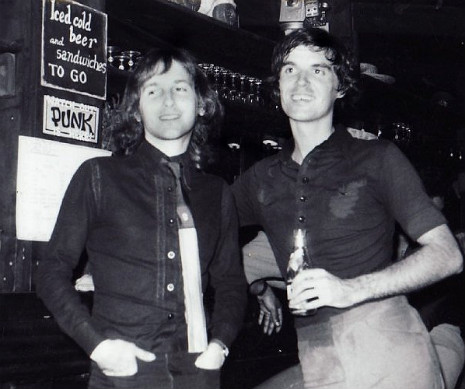
Jeff Salen of Tuff Darts and Talking Heads’ David Byrne at CBGB, 1976. Photo: Robert Spencer.
It has been said that when a city is in decline the arts flourish. I don’t know who said it or when it was said or if anyone actually said it at all. It’s one of those things that sounds true and feels true and when I say it people tend to agree, whether it’s true or not. It certainly seemed true when I arrived with my band in New York City in 1977 to play a Monday night gig at CBGB.
Crawling out of an Econoline van into the humidly dense New York night and having a fistful of Bowery cesspool stench sucker punch me was like being greeted by a Welcome Wagon full of decaying dog dicks. I liked it. I took in a lungful of the jaundiced air and knew immediately that my Muse was there somewhere…stuck like a moth in the viscous Manhattan murk.
The asshole smell of downtown NYC was exactly the kind of reality check I needed after spending six years languishing at the foot of the Rocky Mountains in Boulder, Colorado. I had arrived in 1970s Manhattan ready to have my world dismembered like a frog in anatomy class. I offered my neck to the city’s rusty scalpel with only a bottle of Jack Daniel’s and a bindle of blow to deaden the pain. 25 years later, I came out of surgery a changed man. And I have the scars to prove it. Lovely scars that you can count to determine my age.
In the first few years of living in NYC, I spent most my nights hanging at Max’s, CBGB, Danceteria, The Peppermint Lounge, The Mudd Club, Hurrah’s and countless other clubs soaking in the glorious sounds of local bands like The Patti Smith Group, The Ramones, Blondie, Talking Heads, Suicide, Tuff Darts, Mink DeVille, The Contortions, Steel Tips, The Dictators, The Mumps… many of whom were gaining international reputations for rescuing rock and roll from the corporate death grip of a dying music industry and from its own artistic stagnation. This was not a commercial strategy, it was something closer to a collective religious epiphany. Poets, painters and philosophers were adding guitars and amplifiers to their arsenals of typewriters, journals and canvas to further expand their medium of self-expression and resurrect a pop culture that had shot its wad at the tail end of the Sixties.
While my main interest was with what was happening in the punk clubs, there were major musical tremors snaking throughout Manhattan,The Bronx and Spanish Harlem. Jazz, rap, disco and Latin music were all drawing from some deep well of inspiration in a city that, on the surface, seemed to be collapsing in on itself. The economy, infrastructure and racial division were crushing Gotham like Godzilla-sized pigeons with restless leg syndrome.
Darkness breeds light and pockets of artists, of every color and cultural background, were conjuring all kinds of magic. And the magic was converging and intermingling in a melting pot, a Hessian crucible, in which alchemical beats, rhythms and song were being transmuted into healing vibrations balancing Gotham’s gloomy Kali Yuga yang into Shakti-powered yin transforming the tortured cries of the city into ecstatic utterance you could dance to, fuck to and get high to. Music was the wave that kept the city from tanking. As the garbage piled up on the streets and triumphant rats were raising flags on mounds of rotting debris like rodent versions of the Marines ascending Iwo Jima, glittering disco balls gaily revolved like tin foil prayer wheels in Studio 54 and downtown The Ramones were generating more energy on the Bowery than Con Edison and the psychotic barker from the Crazy Eddie commercials combined. Music provided the make-up, the blush and mascara that gave New York City the appearance of still being alive.
Will Hermes’ exhilarating new book Love Goes To Buildings On Fire: Five Years In New York That Changed Music Forever captures the energy and excitement of New York’s music scene from 1973 to 1978 in all its multitudinous forms. It is richly detailed, never dull, and exhaustively researched. I came to the book knowing most of what there is to know about Manhattan’s punk scene and as someone who was there at the time was pleased to see that Hermes (who was also there) manages to make it all come alive again. This is not a dull slog through familiar turf. Herme’s prose pulses with a rock and roll heart. He loves what he’s writing about. And he’s writing about much more than just what falls within my frame of reference. He sees and connects dots between various scenes creating a kind of musical mandala. From the lofts of downtown avant-garde jazz composers like Philip Glass to the South Bronx and the roots of rap with Kool Herc to disco’s inception spun off the turntables of Nicky Siano to The Fania All-Stars’ explosive sets at the Cheetah Club, Hermes is like a human Google map, giving us the God’s eye view and zooming in right down to the graffiti in the bathroom.
Today, things seems as bleak as they did in New York City during the 1970s. There’s a sense of hopelessness, a sense that things are getting out of control. But underneath the despair there is a subway-like rumbling, a rhythm, a beat, a sensation that something is moving and about to surface and it could be a train entering the station or it could be something like music, something pulling us all together in a movement that thrusts forward into the future and will not be denied. I’ve seen what the power of music can do. I saw it in the Sixties and I saw it again in the Seventies. And right now my eyes are wide open and ready to see it again.
Love Goes To Buildings On Fire is that fine kind of book that takes you backwards and forward at the same time. Will Hermes reminds us that music matters and every revolution, every movement, every cultural and political upheaval, creates its own soundtrack. What will ours be this time around?
Here’s a video mix inspired by Will’s book which includes some seminal songs that came out of New York City in the 1970s.
1. “Jet Boy” - The New York Dolls 2. “Piss Factory” - Patti Smith 3. “X-Offender” Blondie 4. “Born To Lose” - The Heartbreakers 5. “SuperRappin’” - Grandmaster Flash 6. “Darrio” - Kid Creole 7. “The Mexican” - Babe Ruth 8. “Pop Your Funk” - Arthur Russell

Here’s a groovy new mix for DM readers and listeners. “Psychedelic Shake” features 11 Sixties garage rarities. Enjoy.
01. “Filled With Fear” - Iron Butterfly
02. “Here And Her Mountain” - Frantic
03. “Bad Part Of Town” - The Seeds
04. “Can’t Get You Out Of My Mind” - The Tempests
05. “Apricot Brandy” - Rhinoceros
06. “Please Don’t Leave Me” - The Ingredients
07. “Show Me The Way” - Free For All
08. “The Light Hurts My Eyes” Great Scots
09. “I Who Have Nothing” - Liquid Smoke
10. “Midnite Thoughts” - The World Column
11. “Young Man” - Morning Dew
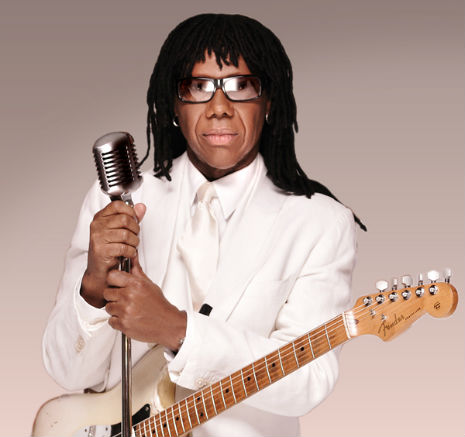
Yes, I am aware that Marc Campbell writing on this blog last month claimed that Everything Is An Afterthought: The Life and Writings of Paul Nelson is the music book of the year—which is why I have fudged the terms here and inserted the word “biography” into the headline. Shouldn’t there be a distinction between writers on music and musicians who write anyway? Well, it doesn’t really matter if you are more interested in the story or the music, as Nile Rodgers’ autobiography Le Freak: An Upside Down Story of Family, Disco and Destiny is packed to the last page with stories and anecdotes that will have you picking your jaw up off the floor.
If you consider yourself a music fan, then Nile Rodgers needs no introduction. He is a hardcore, bona-fide music industry legend. He not only co-wrote some of the biggest hits of the Seventies with his partner Bernard Edwards in the band Chic (“Le Freak”, “Good Times”, “We Are Family”), and produced some of the biggest records of the 80s (Madonna’s Like A Virgin, David Bowie’s Let’s Dance, Duran Duran’s Notorious, Diana Ross’ Diana.) His skills as a guitarist are beyond any doubt and have influenced a generation of musicians not only in the disco, funk and dance genres but further afield in post-punk and even hard rock. At a recent gig in Manchester, Rodgers’ Chic Organisation was joined onstage by The Smiths’ Johnny Marr who sat in on “Le Freak”—the pairing might seem unusual, but listen to their guitar styles and the influence is clear.
Le Freak is Rodgers’ candid autobiography, and what a tale he has to tell. Not only is this one of the most fascinating stories in modern music, with a cast list of some of the biggest stars in the world, but it’s also one of the most under-documented so to hear it coming from the proverbial horse’s mouth is a delight. There’s drugs, sex, rock’n’roll, drugs, booze, disco, hippies, drugs, Black Panthers, bohemians, buppies, drugs and some more drugs for good measure. The years spent playing and writing in Chic, while not given short thrift, are not the main focus of the book. Chic have been well documented elsewhere, in particular the book Everbody Dance: Chic and the Politics of Disco by Darren Easley. But where that book leaves off—namely the coke-fuelled 80s—is where Le Freak really kicks in to gear, with Rodgers working with Ross, Bowie, Ciccone and snorting his way through the GDP of a small country. Any mere mortal would be dead from the amount of coke Rodgers scoffed, but what’s even more impressive is his hardcore work ethic and the fact that he managed to keep it all together (and tight!) while under the influence.
But it’s the early years of Rodgers’ life that are the unexpected highlight. To call his upbringing unusual would be an understatement. Born to his mother when she was just 13, and only a few years before she became a full-time heroin addict, Nile travelled with his mother or one of his grandmothers between New York and LA during the 50s and 60s. His musically gifted father wasn’t present, but Nile ran into him in a couple of times on the street, and got to witness his vagrant lifestyle first hand in a couple of heart-breaking reminiscences. In Los Angeles, at the age of 13, Rodgers drops acid at a hippie pad and ends up hanging out with Timothy Leary. In New York, at the more wizened age of 17, he finds himself tripping balls in a hospital emergency ward as Andy Warhol is wheeled in, having just been shot by Valerie Solanas. This being the kind of incredible life that Rodgers leads, he is able to meet both men later on in life, in very different circumstances, and recount these tales directly to them. He credits events and coincidences like this in his life as something called “hippie happenstance.”
Yet, despite all the major celebrities who make regular appearances throughout the book (I particularly liked the story of meeting Eddie Murphy), this remains distinctly the Nile Rodgers story. It’s clear how important family is to the man, and despite his own family’s unusual set-up and dysfunction, it’s the Rodgers’ clan who are the anchor in this wild tale (even despite their own wild times consuming and selling drugs). Nile’s parents may have been junkies, and genetically predisposed him to his alcoholism, but they taught him about fine art, music, fashion and culture, which is not how heroin-addicted parents are generally perceived by the public.
Le Freak is an excellent book, and worth reading whether you like disco music or not. Nile Rodgers’ is one of the most important composers/musicians/producers of the 20th century, and it’s good to see him finally getting his due. But despite creating the biggest selling single for his then label, Atlantic, and producing the biggest break-out records for a generation of 80s pop superstars, it still packs a punch to read about the discrimination that Rodgers and his music faced from within the industry:
A few weeks later I did a remix of a song of [Duran Duran’s] called “The Reflex”. Unfortunately, as much as Duran Duran liked the remix, their record company wasn’t happy, and I was soon in an oddly similar situation to the conflict Nard and I had had with Diana Ross’ people.
Nick Rhodes called me moments after the band had excitedly previewed my retooling of “The Reflex” to the suits at Capitol Records. “Nile” he began, his monotone stiff-upper-lip English accent barely hiding his despair. “We have a problem”.
My stomach tightened. “What’s up Nick?”
He struggled to find the words. “Capitol hates the record” he finally said.
I was stunned. “The Reflex” was a smash. I was sure of it. This was déja vu all over again.
“How do you guys feel about it?” I asked a little defensively.
“Nile, we love it. But Capitol hates it so much they don’t want to release it. They say it’s too black sounding.”
Too black sounding? I tried not to hit the roof, but in a way it was nice to hear it put so plain. Finally someone had just come out and said it.
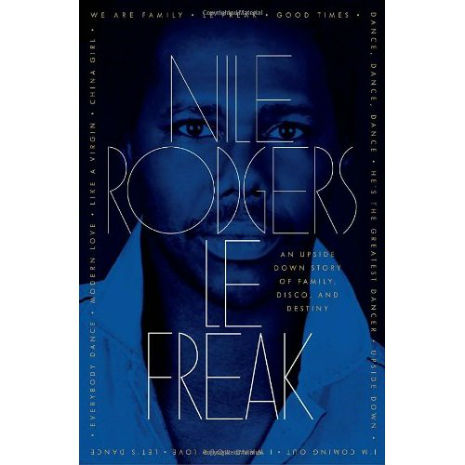
Le Freak: An Upside Down Story of Family, Disco and Destiny by Nile Rodgers is available here.
Previously on Dangerous Minds:
Nile Rodgers dishes the dirt on Atlantic Records
Miles Davis talks about his art on Nile Rodgers’ ‘New Visions’